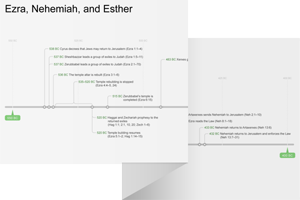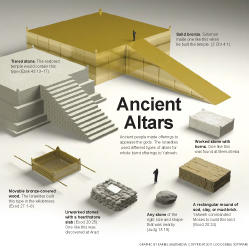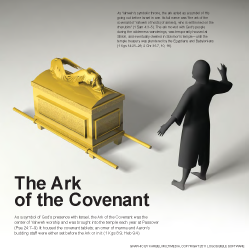3:1–7 The returned Jewish exiles begin by building an altar to Yahweh. This was the first step in establishing proper worship of Yahweh in the land—for which the sacrificial system was of paramount importance. The building of an altar was also a way of thanking Yahweh for restoring them to the land. Abraham built an altar to Yahweh immediately after entering the land for the first time (Gen 12:7). Joshua likewise built an altar to Yahweh after entering the land following the exodus (Josh 8:30–31). |
3:1 seventh month Tishri (late September and early October) according to the Jewish calendar.
(late September and early October) according to the Jewish calendar. The year is probably 538 bc.
The year is probably 538 bc.
 Calendars in Old Testament Times
Calendars in Old Testament Times
3:2 Jeshua The name “Jeshua” (or “Joshua”), which means “Yahweh is salvation,” is the ot equivalent of the name Jesus. Jeshua was the son of Jozadak and of the priestly family of Jedaiah, one of the 24 priestly families organized by David (compare 1 Chr 24:7). He was also the grandson of Seraiah, the high priest during the destruction of Jerusalem (compare 1 Chr 6:14; 2 Kgs 25:18). Jeshua was the first high priest of the Jewish community that returned from exile.
Zerubbabel Means “the seed of Babel” or “born in Babel.” Zerubbabel served as the governor of Judah. Since Sheshbazzar is not mentioned here, he may have died by this time. Or, he may have returned to Babylon after leading the returnees back to Judah.
burnt offerings Since the burnt offerings began on the first day of the seventh month (Ezra 3:6), the altar was likely rebuilt prior to the seventh month.
the altar of the God of Israel In accordance with the Law, the new altar would have been built using unhewn stones (Exod 20:25; Deut 27:6).
would have been built using unhewn stones (Exod 20:25; Deut 27:6).
 Altars in the Old Testament Table
Altars in the Old Testament Table
the man of God A commonly used title to denote a prophet of Yahweh (1 Sam 2:27; 9:6; 1 Kgs 13:1). Here it likely refers to Deut 33:1, where the phrase is applied to Moses (Josh 14:6).
of Yahweh (1 Sam 2:27; 9:6; 1 Kgs 13:1). Here it likely refers to Deut 33:1, where the phrase is applied to Moses (Josh 14:6).
3:3 on its foundations The new altar was built on the foundation of the previous one.
they were in terror In order to build the new altar, the people had to destroy the previous one used by the Jews, Samaritans, and foreigners who lived near Jerusalem during the exile (Jer 41:5). The destruction of the altar surely infuriated these groups, which may account for the rift between those who returned from Babylon and those who remained in the land (Ezra 4:1–5).
the peoples of the lands A general reference to the foreign inhabitants of Judah and the surrounding provinces, including the nations of Edom and Ammon—the traditional enemies of Israel.
and the surrounding provinces, including the nations of Edom and Ammon—the traditional enemies of Israel.
burnt offerings for the morning and the evening Each day, morning and evening, the burnt offering consisted of a lamb prepared with flour, oil, and wine (Exod 29:38–42; Num 28:2–8). These sacrifices were previously restored by Joash (2 Chr 24:14) and Hezekiah (2 Chr 29:7, 27–29).
3:4 the feast of booths One of the three pilgrimage festivals where every Jewish male was expected to be in Jerusalem (Deut 16:16). The Feast of Booths (or Tabernacles) was an autumn harvest festival celebrated from the 15th to the 21st of the seventh month (Tishri) (see note on Lev 23:33–44). During this week, the Jews were required to live in booths (or tents) set up around Jerusalem to commemorate the wilderness wanderings of the exodus generation. The dedication of Solomon’s temple also took place during the Feast of Booths (1 Kgs 8:2, 65).
(or Tabernacles) was an autumn harvest festival celebrated from the 15th to the 21st of the seventh month (Tishri) (see note on Lev 23:33–44). During this week, the Jews were required to live in booths (or tents) set up around Jerusalem to commemorate the wilderness wanderings of the exodus generation. The dedication of Solomon’s temple also took place during the Feast of Booths (1 Kgs 8:2, 65).
 Israelite Festivals Table
Israelite Festivals Table
 Israelite Calendar Table
Israelite Calendar Table
described for each day A special sacrifice was offered on each of the seven days of this feast (see Num 29:12–38; Lev 23:33–36, 39–43). Both the first day of the feast and the day after the feast ended were days of rest.
3:5 the appointed times The festivals with fixed dates include new moon celebrations, Passover, the Feast of Unleavened Bread, the Feast of Firstfruits, the Feast of Weeks (Pentecost), the Feast of Trumpets, the Day of Atonement, and the Feast of Booths (Tabernacles). See the festival calendars in Lev 23 and Num 28–29.
with fixed dates include new moon celebrations, Passover, the Feast of Unleavened Bread, the Feast of Firstfruits, the Feast of Weeks (Pentecost), the Feast of Trumpets, the Day of Atonement, and the Feast of Booths (Tabernacles). See the festival calendars in Lev 23 and Num 28–29.
who gave a freewill offering A voluntary sacrifice that could be offered whenever an individual felt led to do so (Lev 22:18–23; Num 29:39).
3:6 the first day of the seventh month The date of the Feast of Trumpets, or Rosh Hashanah. Assuming a year of 538 bc, the date was September 17.
or Rosh Hashanah. Assuming a year of 538 bc, the date was September 17.
was not yet founded The next major section of the book deals with the rebuilding of the temple. Even though the altar had been rebuilt and the sacrificial system reinstituted, the work was not complete. God wanted the entire temple rebuilt (Hag 1).
Even though the altar had been rebuilt and the sacrificial system reinstituted, the work was not complete. God wanted the entire temple rebuilt (Hag 1).
3:7 money The Jews prepare to build the temple’s foundation by hiring masons and carpenters, whose skills were essential to the project. These skilled laborers were hired with money likely taken from the treasury referred to in Ezra 2:69.
food, drink, and olive oil Following the example of Solomon, the people contracted the Phoenicians to bring timber from Lebanon to the port city of Joppa (compare 2 Chr 2:16). The Phoenicians were paid with food, drink, and oil—just as they had been during the time of Solomon.
Sidonians Sidon was a city located on the shores of the Mediterranean Sea, about 20 miles north of Tyre and about 95 miles north of Joppa.
was a city located on the shores of the Mediterranean Sea, about 20 miles north of Tyre and about 95 miles north of Joppa.
Tyrians Tyre was a city located on the shores of the Mediterranean Sea, about 20 miles south of Sidon. Both Tyre and Sidon were included in the territory allotted to the tribe of Asher (Josh 19:28–29).
was a city located on the shores of the Mediterranean Sea, about 20 miles south of Sidon. Both Tyre and Sidon were included in the territory allotted to the tribe of Asher (Josh 19:28–29).
cedar trees Cedars from Lebanon—greatly prized throughout the ancient Near East—appear throughout the ot as a symbol of worldly strength, surpassed only by Yahweh’s power (see Psa 29:5; Isa 2:13; Amos 2:9; Zech 11:2). They were also used to build the Jewish temple at Elephantine in Egypt (see note on Isa 49:12).
Joppa A city located about 30 miles northwest of Jerusalem on the shores of the Mediterranean Sea. It was included in the territory allotted to the tribe of Dan (Josh 19:46). Because of its harbor, it served as the port city for Jerusalem.
located about 30 miles northwest of Jerusalem on the shores of the Mediterranean Sea. It was included in the territory allotted to the tribe of Dan (Josh 19:46). Because of its harbor, it served as the port city for Jerusalem.
according to the authorization over them of Cyrus likely needed to approve this transaction since it involved multiple provinces in the Persian Empire.
3:8 the second year The rebuilding of the foundation occurs about seven months after the events of Ezra 3:4–6.
second month Iyyar (late April and early May). The year is probably 537 bc.
the remainder of their brothers Although Sheshbazzar is not named here, he evidently had a hand in the project; he is credited with it in Ezra 5:16.
twenty years and older Levites now took on responsibility at the age of 20 (1 Chr 23:24; 2 Chr 31:17). Originally, one had to be 25 (Num 8:24)—and those who carried the tabernacle were required to be at least 30 (Num 4:3, 23, 30). The minimum age may have been lowered because the total number of Levites kept declining. This change would ensure that there were always enough Levites to fulfill the temple duties.
now took on responsibility at the age of 20 (1 Chr 23:24; 2 Chr 31:17). Originally, one had to be 25 (Num 8:24)—and those who carried the tabernacle were required to be at least 30 (Num 4:3, 23, 30). The minimum age may have been lowered because the total number of Levites kept declining. This change would ensure that there were always enough Levites to fulfill the temple duties.
direct The priesthood oversaw the project to ensure that it was ritually correct.
3:9 Kadmiel A Levite (see Ezra 2:40) who was granted the privilege of standing on the platform as the book of the law was read in Neh 9. He also signed the sealed document of Neh 10:28–39.
3:10 laid the foundation of the temple of The returned exiles may have simply repaired the foundation of Solomon’s temple rather than building a new one from scratch. Second Kings 25:9 indicates only that the temple was burned, which makes it possible that the original foundation remained intact.
trumpets The trumpets here are probably not the ram’s horn often used for signal calls. Both instruments are typically translated “trumpet.”
3:11 loyal love is everlasting for Israel This celebration echoes 2 Chr 5:13. This refrain is used throughout the Psalms (Pss 100:5; 106:1; 107:1; 118:1; 136:1).
 Chesed Word Study
Chesed Word Study
3:12 elderly priests, Levites, and heads of the families who had seen The first temple was destroyed in 586 bc. The date is now ca. 537 bc, meaning that these men are well over 50 years old.
3:13 from afar Perhaps as much as five miles.

|
About Faithlife Study BibleFaithlife Study Bible (FSB) is your guide to the ancient world of the Old and New Testaments, with study notes and articles that draw from a wide range of academic research. FSB helps you learn how to think about interpretation methods and issues so that you can gain a deeper understanding of the text. |
| Copyright |
Copyright 2012 Logos Bible Software. |
| Support Info | fsb |
 Loading…
Loading…





